Why Read This Article?
Finish Nailer Repair - Replacing the Driver Guide (Ridgid Part # 79004001022)
Article Breakdown
Finish Nailer Repair - Replacing the Driver Guide (Ridgid Part # 79004001022)
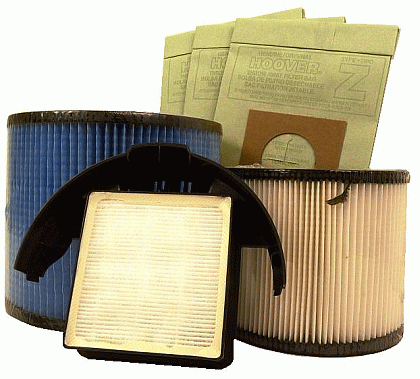 In addition to being a strong indicator of a vacuum's cleaning power, filters are also important vacuum replacement parts.
Knowing how many filters your vacuum has and the types of filters it uses will help with proper maintenance and filter replacement.
In addition to being a strong indicator of a vacuum's cleaning power, filters are also important vacuum replacement parts.
Knowing how many filters your vacuum has and the types of filters it uses will help with proper maintenance and filter replacement.
Read about the basics of vacuum filter functions, types, features, and parts matching below to prepare for your next vacuum purchase or filter change.
Primary and Secondary Vacuum Filters
It's easy to think of vacuums as simply "sucking in dirt," but that's not completely accurate.
What vacuums really do is (1) pull in air and dirt, (2) catch most of the larger airborne dirt and dust particles in a collection area, and then (3) filter the outgoing air for smaller particles before (4) expelling the clean air out its exhaust.
(Filterless vacuum designs separate dust from the air using centrifugal force.)
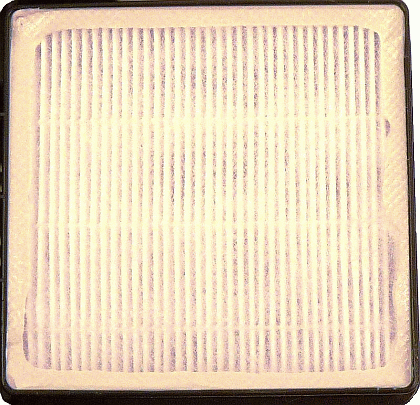
Many vacuum cleaners these days have more than one filter as part of their air cleaning system.
In vacuum cleaners that use two or more filters, one of the filters (and only one) acts as the primary filter, while the other(s) serve in secondary roles.
Primary filters are responsible for collecting most of the dirt and dust out of the air that the vacuum sucks inside of itself.
Secondary filters work to further filter the air, either before making contact with sensitive areas of the machine and/or before leaving the vacuum.
The presence and quality of secondary vacuum filters is especially important for vacuum owners concerned with allergens, pet dander, and airborne microbes.
Although primary and secondary filters do different jobs, they can both take the shape of nearly any vacuum filter shape or type described below, depending on the vacuum model.
[Back to top]
Vacuum Filter Types
Material, shape, and collection method are among some of the characteristics that separate vacuum filter types from one another.
Although there are several kinds of filters used on the market, vacuum filters (and the vacuums that use them) generally get sorted into two groups:
1. bag filters/vacuums, and
2. bagless filters/vacuums.
The debate surrounding which filtration style works more effectively still rages. User preference seems to be the only emerging victor.
Whatever your preference, knowing what type of filter your vacuum uses helps with understanding how it works and how to care for it.
Bag Filters
This is the most common vacuum filter type, and one that has proven to be effective at two jobs, not just one.
Air entering a bag filter vacuum is directed into the bag. The vacuum's suction then pulls the air inside the paper bag outside the bag through the pores in the paper, leaving particles larger than the paper pores behind.
Bag filters work this way to both filter air and collect material.
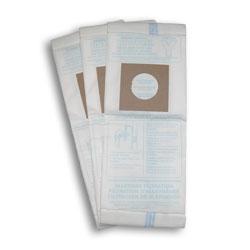
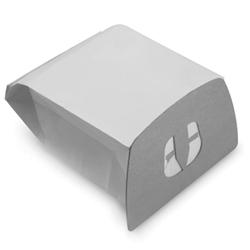 Vacuum bags are made to be disposed of after filling up in order to take the dirt they collect with them to the garbage.
There are dozens of vacuum bag "Types" still in use today that follow a fairly-standardized naming system between manufacturers. The bags pictured above are Type Y (left) and Type F (right).
Each bag filter vacuum model uses only one type of vacuum bag. Bag filters are not limited to use in just one kind of vacuum design either, meaning that canister, upright, broom, and other vacuum styles commonly use a bag filter system.
Vacuum bags are made to be disposed of after filling up in order to take the dirt they collect with them to the garbage.
There are dozens of vacuum bag "Types" still in use today that follow a fairly-standardized naming system between manufacturers. The bags pictured above are Type Y (left) and Type F (right).
Each bag filter vacuum model uses only one type of vacuum bag. Bag filters are not limited to use in just one kind of vacuum design either, meaning that canister, upright, broom, and other vacuum styles commonly use a bag filter system.
Bag filters are almost always primary filters.
[Back to top]
Cartridge Filters
Like bag filters, most cartridge vacuum cleaners are disposable and meant for replacement. One advantage to cartridge filters is that vacuum owners can remove them and tap the built-up dust out of them between filter changes.
Some vacuum owners consider this design to be more convenient than bag filters,
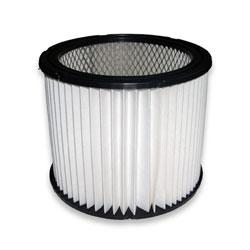
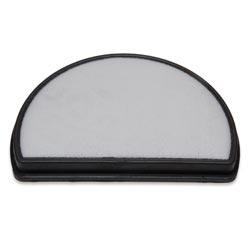 Also, most cartridge filters are extremely easy to replace since their rubber (or plastic) casings help them slide into their tightly-fitting places in vacuums.
Cartridge filters are designed in countless shapes to accommodate diverse vacuum designs, including: square, round, rectangle, cylinder, and unique shapes like the dust cup filter pictured above (on the right).
Cartridge filters can be either primary or secondary filters, depending on the vacuum model. They can also be made of several materials, including foam, paper fiber, pleated paper, and synthetic materials.
[Back to top]
Also, most cartridge filters are extremely easy to replace since their rubber (or plastic) casings help them slide into their tightly-fitting places in vacuums.
Cartridge filters are designed in countless shapes to accommodate diverse vacuum designs, including: square, round, rectangle, cylinder, and unique shapes like the dust cup filter pictured above (on the right).
Cartridge filters can be either primary or secondary filters, depending on the vacuum model. They can also be made of several materials, including foam, paper fiber, pleated paper, and synthetic materials.
[Back to top]
Disc Filters
Some vacuum makes and models employ a disc shaped filter as the primary separation and/or collection system.
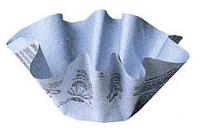 As can be seen above, these filters are shaped almost exactly like coffee filters and are manufactured in paper or cloth.
[Back to top]
Foam Filters
As can be seen above, these filters are shaped almost exactly like coffee filters and are manufactured in paper or cloth.
[Back to top]
Foam Filters
Most foam vacuum cleaner filters serve in secondary roles cleaning the already-dust-separated air once again before it leaves the vacuum. Some vacuum models use foam filters as the primary filter above the machine's dust cup.
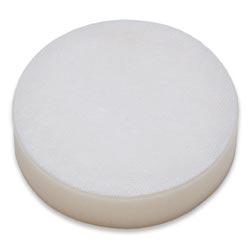 A great advantage to foam filters is that some of them can be washed, dried, and then re-used.
If your vacuum model uses foam filters, check the vacuum's owner's manual to find out if the filters are washable.
[Back to top]
Cloth Filters
Cloth filters are commonly used in larger, debris-clearing vacuum models used in shops and construction sites.
Cloth filters are less temporary than other vacuum filters because of their toughness and--in most cases--their wash-ability.
A great advantage to foam filters is that some of them can be washed, dried, and then re-used.
If your vacuum model uses foam filters, check the vacuum's owner's manual to find out if the filters are washable.
[Back to top]
Cloth Filters
Cloth filters are commonly used in larger, debris-clearing vacuum models used in shops and construction sites.
Cloth filters are less temporary than other vacuum filters because of their toughness and--in most cases--their wash-ability.
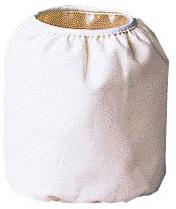 [Back to top]
Vacuum Filter Filtration Features
[Back to top]
Vacuum Filter Filtration Features
In addition to the structural and material vacuum filter differences mentioned above, vacuum owners also have their pick of several filtration features that can be combined with almost any filter.
Depending on your cleaning and health needs, you may want to consider one of the following features the next time you replace a vacuum filter.
Allergen-
Filters advertised as "Allergen" filters are designed to separate smaller particles from the air than standard filters can capture.
The vacuum industry isn't always completely clear about the exact specifications of "Allergen" filters, but the idea is that their filtration power lies somewhere between that of a HEPA filter and a standard filter.
HEPA-
HEPA stands for High Efficiency Particulate Air, and is an air filtration system originally designed for very high sensitivity air filtration situations, like removing radioactive air particles.
Since their invention, HEPA filters have been put to use more widely in a number of consumer applications, including vacuums.
Using a network of specifically-sized fibers, HEPA filters remove up to 99.995% of airborne particles of .3 microns or larger. This means that a properly-rated HEPA vacuum filter will remove nearly every allergen, pathogen, and asthma-inducing particle from the air.
Here's the catch: In order for a HEPA filte'rs amazing filtration to actually benefit vacuum users, the vacuum design in which it is used must be air tight.
It wouldn't do any good to apply such heavy-duty filtration to air leaving a vacuum's exhaust, for example, if air inside the vacuum is able to leak out the machine's casing or from somewhere else on the unit.
When a HEPA filter is truly needed for health reasons, vacuum shoppers should take extra care in selecting a vacuum model that meets the high standards of the filtration technology it uses. Read specifications and reviews. Find out which health organizations (if any) use the vacuum model you're looking at.
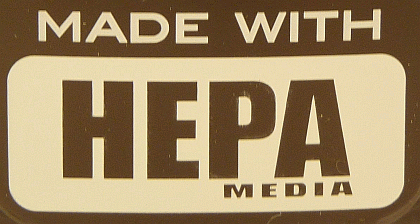
To add to the confusion, many filters are marketed by manufacturers as "HEPA," "True-HEPA," and "HEPA-like" when they are not properly HEPA-rated. A properly-rated HEPA filter will include its specific ratings somewhere on the filter or its packaging, as well as a serial number somewhere on the filter.
MicroFresh-
MicroFresh is a non-toxic chemical additive that greatly inhibits the growth of bacteria, fungi, and algae.
It can be applied to nearly any vacuum filter by manufacturers as a measure to further sterilize the air passing through a vacuum.
Carbon/Charcoal-
Carbon and charcoal filters are especially good at filtering odor-causing particles from the air. These can be found in most filter styles and types.
Scented-
If filtering odor-causing particles out of the air doesn't sound like enough, scented vacuum filters can be used to add pleasant smells to a vacuum's outgoing air.
Manufacturers offer a variety of scents, and scented filters are available in several filter types.
For vacuums that have more than one filter, using a scented secondary filter in combination with a primary anti-microbial filter is a popular strategy among owners.
Pet-
Most vacuum makers produce and advertise some filters as "Pet" filters.
These are usually designed to specifically filter pet hair and dander out of the air while eliminating odors, often by the addition of baking soda to the filter.
Washable-
As mentioned before, manufacturers lengthen the expected life of some filters by engineering them to be washable. Washable vacuum filters are usually labeled clearly as such.
Wet/Dry-
Wet/dry vacuums and carpet cleaners must have wet/dry filters to work properly. It's a common mistake to replace a wet/dry filter with a standard dry filter.
[Back to top]
How to Match a Replacement Vacuum Filter
Using a vacuum's model number is the most accurate way to find its correctly matching filter.
Most manufacturers use some kind of naming system to organize the large amount of filters that they produce, but these naming systems are seldom consistent across the industry. Also, they can even be confusing within one manufacturer.
Because of this, the vacuum model number is the surest way to find the filters you need.
One exception to this guideline might be when it comes to bag filters. As mentioned above, bag filters follow a "Type A, Type B, . . . etc." naming system that is reasonably consistent for most vacuum manufacturers.
If you know the type of bag filter that you vacuum uses, using its type name to match a replacement isn't a bad idea.
That being said, it still never hurts to double check the model number of your vacuum or to look its bag type up in its owner's manual.
[Back to top]
Conclusion
eReplacementParts.com is proud to offer its specialized online parts replacement service to vacuum owners!
Our inventory includes vacuum filters and other parts for several major vacuum brands.
To order a replacement filter for your vacuum, simply enter its model number in the search field at the top of this or any eReplacmentParts web page. Use your vacuum's breakdown diagram and detailed parts list to select the desired filter.
Also, you can visit our Vacuum Bags accessories page to view our inventory of vacuum filter bags. Our integrated search features allow customers to narrow the results displayed on the page by style, manufacturer, and filtration features.
Finally, remember that filter replacements are just a matter of time.
For vacuum filters that don't come in packs of two or more, ordering an extra filter as a back-up can save you from having to stop in the middle of your work the next time a filter is ready for the garbage!
[Back to top]
What we're about.


















































